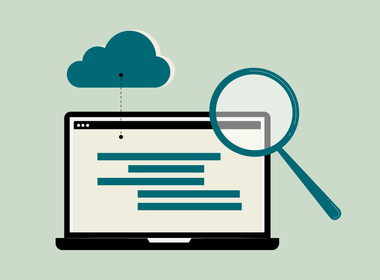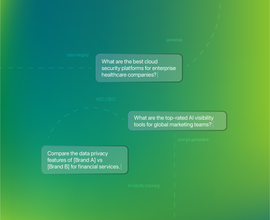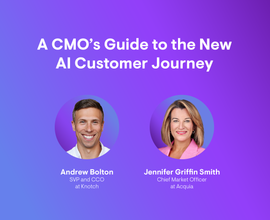Scraping vs. API: How to Track Brand Visibility in AI Search
As consumers turn to AI for answers, monitoring your brand's presence is essential. But common methods like UI scraping are risky and unreliable. Discover the compliant, scalable way to track your brand's visibility across AI platforms.
The digital marketing landscape has fundamentally shifted. Traditional SEO strategies focused on Google rankingsRankings
Rankings in SEO refers to a website’s position in the search engine results page.
Learn more are no longer sufficient in our AI-first world. Today, more and more consumers turn to AI solutions like ChatGPT , Claude , Gemini , and Perplexity to get instant, personalized answers to their questions.
Imagine this scenario: A potential customer asks ChatGPT, "What's the best CRM software for small businesses?" or "What are the top alternatives to Adobe Creative Suite?" The AI's response could make or break your brand's visibility. If your company isn't mentioned in these AI-generated recommendations, you're essentially invisible to a growing segment of your audience.
This shift represents a seismic change in how brands need to approach digital visibility. Unlike traditional search engines, where you could optimize for specific keywords and track rankings, AI search presents unique challenges:
- Conversational queries replace keyword-based searches
- Contextual recommendations matter more than page rankings
- Real-time brand mentions in AI responses directly impact purchasing decisions
- Multiple AI platforms require multiple visibility strategies
The stakes couldn't be higher. Research shows that consumers trust AI-generated recommendations, often viewing them as more objective than traditional advertising. If your brand consistently appears in AI responses for relevant queries, you gain a significant competitive advantage. If it doesn't, you risk losing market share to competitors who do.
This reality has led many marketing teams to grapple with a critical question: How do we effectively monitor and track our brand's presence across AI-powered search platforms? The answer isn't straightforward, and the approach you choose could determine your success in the AI search era.
The monitoring challenge: Two distinct approaches
Given how important AI search visibility is becoming, marketing teams face a fundamental choice in how they track and analyze their brand's presence. Two primary approaches have emerged: UI scraping and API-based monitoring.
The choice between these methods will determine the quality of your data, as well as the scalability, compliance, and long-term viability of your AI search tracking strategy.
Option A: UI scraping (crawling the LLMs)
How UI scraping works
UI scraping, also known as web scraping or crawling, involves creating automated bots that simulate human user behavior. These crawlersCrawlers
A crawler is a program used by search engines to collect data from the internet.
Learn more log into AI platforms like ChatGPT, submit queries through the web interface, and extract the generated responses for analysis.
Crawlers simulate human users—they log in, trigger prompts through ChatGPT's web interface, and scrape the responses for brand mentions and competitive analysis.
The disadvantages of UI scraping
While UI scraping might seem like a straightforward solution, it introduces multiple critical challenges that can undermine your entire monitoring strategy:
1. Extreme fragility
- UI updates break scrapers: AI platforms frequently change their UI layouts, user flows, and page structures. Even minor tweaks can cause scrapers to fail, leading to incomplete or missing data without warning.
- Geographic blocking: Many AI platforms use location-based controls to serve region-specific content or block access altogether.
- Rate limiting and anti-bot defenses: Sophisticated detection systems can identify and block scraping attempts, which can trigger rate limits, CAPTCHA challenges, or outright bans.
- Authentication complexity: Multi-factor authentication, CAPTCHA systems, and session management create constant maintenance overhead and constant updates to handle evolving login flows.
2. Severely limited coverage
- Single configuration bias: Scrapers typically capture only one UI configuration (e.g., desktop ChatGPT with specific settings enabled), so results reflect only one specific type of user.
- Device limitation: AI outputs can differ on mobile vs. desktop, or based on voice interfaces and third-party integrations.
- Feature-specific results: Whether browsing is enabled, plugins are installed, or specific LLM models are selected can all impact AI responses. Scraping typically lacks the ability to test across these variations consistently.
- Temporal inconsistency: What your scraper sees at one moment might not match what real users see an hour later, introducing reliability issues.
3. Serious compliance and legal risks
- Terms of Service violations: Most AI platforms explicitly prohibit automated scraping in their terms of service.
- IP blocking and account suspension: Platforms actively detect and penalize scraping activity.
- Data integrity concerns: Scraped data may not accurately represent actual user experiences.
4. Technical and operational challenges
- High maintenance overhead: Keeping a scraper working requires constant upkeep.
- Scalability limitations: It’s difficult to scale a scraping solution across multiple platforms, queries, and timeframes.
- Data quality issues: Scrapers often return raw HTML or unstructured text that needs to be cleaned and parsed before analysis.
- Resource intensive: Requires significant infrastructure and ongoing technical support to operate a scraper, especially at an enterprise level.
Option B: Official API + web-search tool integration
How API-based monitoring works
The superior approach leverages official APIs provided by AI platforms, specifically utilizing web search capabilities to track real-time brand mentions and competitive positioning.
This approach allows you to:
- Log every prompt systematically across multiple query variations
- Detect search trigger events through tool_calls metadata
- Capture real-time citation data with structured web references
- Scale monitoring across thousands of queries in a compliant, sustainable manner
The advantages of API-based monitoring
1. Scalability and repeatability
- Batch processing capability: Allows you to execute thousands of prompts across multiple models, geographic locations, and timeframes to gain visibility across campaign initiatives, product lines, and competitors.
- Automated scheduling: Set it and forget it. Schedule continuous monitoring without the need for manual intervention.
- Cross-platform consistency: Maintain uniform tracking across different AI platforms.
- Historical analysis: Build comprehensive datasets for trend analysis and reporting
2. Transparency and auditability
- Structured metadata: tool_calls provide explicit documentation of when a web search was triggered, so you can distinguish hallucinated answers from grounded ones.
- Citation tracking: API responses include direct access to web sources referenced in AI responses.
- Reproducible results: API outputs are consistent and controlled, so you can rerun queries and get dependable results.
- Compliance documentation: API logs create a complete audit trail for legal and regulatory compliance.
3. Full compliance assurance
- Terms of Service alignment: Fully compliant with OpenAI's official terms and conditions.
- Legal risk mitigation: Eliminates exposure to the Computer Fraud and Abuse Act (CFAA) and other legal frameworks.
- Platform relationship preservation: Unlike scraping, which can result in penalties or bans, API maintains a positive standing with AI platform providers.
- Sustainable long-term strategy: Presents no risk of account suspension or access revocation.
4. Superior data quality
- Real-time web citations: Offers access to current, citation-backed search results.
- Structured response format: Surfaces data with consistent formatting that’s optimized for analysis.
- Rich metadata: Provides comprehensive context about query processing and result generation.
- Error handling: Has built-in error management and response validation.
5. Accurate behavior detection
- Precise search trigger identification: Accurately logs which prompts trigger web search functionality.
- Context-aware analysis: Provides an understanding of how different query types influence search behavior.
- UI logic simulation: Offers a more accurate representation of actual AI behavior than surface-level scraping.
- Real user experience correlation: Allows for better alignment with actual user interactions across platforms.
Comprehensive side-by-side analysis
UI Scraping | API | |
|---|---|---|
Stability & reliability | Silently breaks during UI updates, authentication changes, and bot detection measures | Stable, version-controlled API with guaranteed backward compatibility |
Legal & compliance risk | High risk—likely violates Terms of Service | Fully compliant with LLMs’ official terms and conditions |
Behavior accuracy | Incomplete—captures only one narrow user configuration and location | Precise—logs exactly which prompts triggered search with full context |
Scalability | Costly infrastructure, proxy maintenance, constant anti-bot countermeasures | API-native, elastic scaling, repeatable across thousands of queries |
Data quality | Raw HTML dumps that require complex parsing and often contain errors | Structured |
Maintenance requirements | Constant updates needed for UI changes, high ongoing technical overhead | Minimal maintenance, automatic updates via API versioning |
Cross-platform coverage | Requires separate scraping infrastructure for each AI platform | Unified approach works across multiple AI platforms with API support |
Real-time monitoring | Delayed by scraping cycles and processing overhead | Instant API responses enable real-time brand mention alerts |
Addressing common objections to API-based monitoring
Objection 1: Scraping replicates real user experience.
The Reality: Real users span multiple models, applications, devices, and configurations—not just a single browser session. Modern AI usage patterns include:
- Multi-device interactions: Users switch between desktop, mobile, and voice interfaces
- Cross-platform behavior: Queries span ChatGPT, Perplexity, Gemini, and specialized AI tools
- Varied configurations: Different users have different settings, plugins, and feature access
- Geographic diversity: User location affects AI response patterns and available features
Why API monitoring wins: API-based monitoring can simulate this diversity by testing across multiple models, configurations, and parameters systematically. Scraping, by contrast, reflects only one narrow scenario and misses the broader user experienceUser Experience
User experience (or UX for short) is a term used to describe the experience a user has with a product.
Learn more landscape.
Objection 2: APIs only return stale training data.
The Reality: Modern AI APIs with web search capabilities provide:
- Real-time web data through integrated search functionality
- Current citations from recent web sources
- Fresh information that extends beyond training data cutoffs
- Dynamic responses that reflect current market conditions and trends
“The claim that crawling is the only way to get accurate behavior is just flat-out not true,” Conductor’s Chief Product Officer, Wei Zheng, emphasizes that every major LLM—ChatGPT, Gemini, Claude, Perplexity—supports grounding search via APIs, making the crawl-only argument obsolete.
Conclusion: The clear path forward
The choice between UI scraping and API-based monitoring isn't just a technical decision—it's a strategic one that will determine your success in the AI search era. While scraping might seem like a quick solution, it creates more problems than it solves: fragility, compliance risks, limited coverage, and ongoing maintenance overhead.
API-based monitoring with web search integration represents the clear winner for organizations serious about tracking their brand presence in AI-powered searches. The good news for enterprise brands is that Conductor, the #1 AI search and content intelligence platform, leverages API-based monitoring. Conductor’s API-based monitoring offers:
- Scalable, reliable infrastructure that grows with your needs
- Complete compliance with platform terms and legal requirements
- Superior data quality with structured, analyzable results
- Comprehensive coverage across multiple AI platforms and query types
- Future-proof architecture that evolves with AI platform capabilities
The time to act is now. As AI search continues to reshape how consumers discover and evaluate products and services, brands that implement robust, compliant monitoring strategies will gain a significant competitive advantage. Those that rely on fragile, non-compliant scraping approaches risk being left behind—or worse, facing legal and operational consequences that could have been easily avoided.
Make sure your brand is visible, compliant, and positioned for success in this new landscape.







